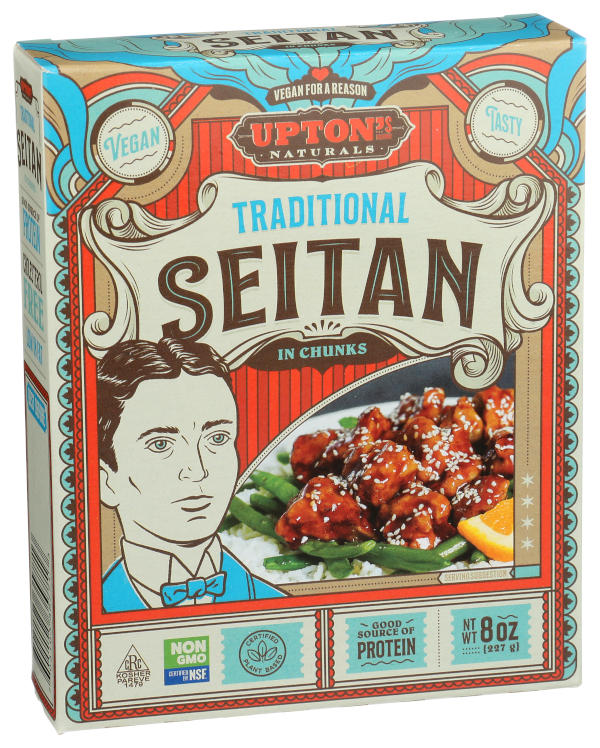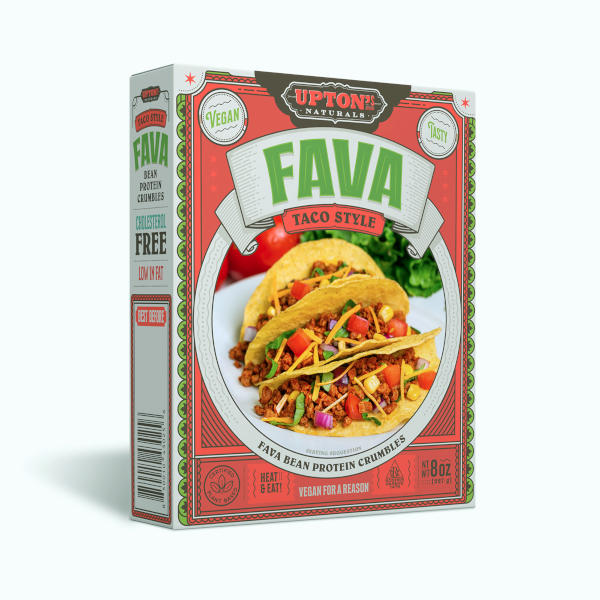A recent survey of 1,000 U.S. adults on their attitudes toward vegan-focused found that more Americans are interested in adding plant-based foods to their diets but often struggle to do so.
Results from the survey, conducted by Wakefield Research on behalf of Saputo Dairy USA and its dairy-free cheese brand, Vitalite, revealed that a third (31%) of Americans substitute meat, cheese or dairy with a plant-based alternative in an average of eight meals a week, suggesting that while they may not go fully vegan, there is a growing appetite to follow an occasional plant-based or flexitarian diet.
Among those who hadn’t tried plant-based alternatives, the top reason they say they won't consider trying is the assumption that products will taste bad (45%). More than 1 in 10 (12%) said it's because they don't know how to cook with plant-based substitutes.
 In the last 10 years, Upton’s Naturals has experienced a near 600% growth, bringing the first seasoned seitan to market. Courtesy Upton’s Naturals.
In the last 10 years, Upton’s Naturals has experienced a near 600% growth, bringing the first seasoned seitan to market. Courtesy Upton’s Naturals.
“I’ve been a vegan for over 30 years and started Upton’s Naturals in 2006, because I couldn’t find simple-to-prepare meat alternatives made from real and recognizable ingredients in stores. Our first product was Italian Seitan, which I started making out of a shared kitchen and selling to local Chicago restaurants,” said Dan Staackmann, founder of Upton’s Naturals, an independently-owned company making plant-based meats including seitan, fava and jackfruit.
In the last 10 years, Upton’s Naturals has experienced a near 600% growth, bringing the first seasoned seitan to market and expanding to new categories like their Fava Taco Style Crumbles and the Updog, a vegan take on the Kosher beef hot dog, along with shelf-stable items like pre-cooked mac & ch’eese, banana blossom in a pouch, pre-shredded jackfruit and a line of vegan soups.
Seitan and jackfruit are versatile meat alternatives that have been enjoyed for thousands of years.
“Seitan is a traditional Japanese food made by rinsing the starch away from wheat and retaining the protein. It’s minimally processed, has an impressively meat-like texture and is both high in protein and low in fat without the cholesterol associated with meat. Young, unripe jackfruit, like what we use at Upton’s Naturals, is native to Southeast Asia and has a neutral flavor and fibrous texture that makes it a great swap for pork, chicken, or fish,” Staackmann said. “We’ve taken these traditional recipes and updated them for today’s consumers with options that are ready to heat and eat.”
 This heat-and-eat meat alternative is made from a soy and wheat-free fava bean base and flavored with a custom blend of taco seasonings. Courtesy Upton’s Naturals.
This heat-and-eat meat alternative is made from a soy and wheat-free fava bean base and flavored with a custom blend of taco seasonings. Courtesy Upton’s Naturals.
For example, Upton’s Naturals recently took inspiration from its best-selling Chorizo Seitan and created Fava Taco Style Crumbles. This heat-and-eat meat alternative is made from a soy and wheat-free fava bean base and flavored with a custom blend of taco seasonings with a taste and texture resemble slow-cooked ground beef.

Would you like to be alerted when new Farm to Frozen articles are posted?
Sign up to receive our eNewsletter, What's HOT in COLD! This weekly eNewsletter showcases the latest trends, news technologies and products impacting the refrigerated, chilled and frozen segment. It also includes a notice when new Farm to Frozen content drops! Sign up now to get on the list!
“We’ve also seen a growing interest in unseasoned, ‘old-school’ meat alternatives like seitan, which allow home cooks to get creative by adding their own sauces and seasonings,” Staackmann said.
Two categories poised to make an impact in 2023 are fermentation-derived proteins or precision fermentation and mycelium-based ingredients.
“In the (fermentation-derived category), Perfect Day has already had several products on the market that use their whey protein, which is derived from yeast cells. In 2023, it will be interesting to watch how they modify their portfolio to lean into areas that are growing, and modify or eliminate ones that are not,” said Sebastian Bohn, sub market leader, Alternative Proteins at CRB. “Mycelium-based ingredients are considered whole foods, so they offer great potential for clean ingredient labels. Plus, they have some awesome nutritional benefits. Some manufacturers, such as Meati Foods and Better Meat Company, are able to provide an array of nutrients that are uncommon in plant-based foods, such as vitamin B12.”
“We think that the industry is just getting started with fermentation-derived ingredients,” he said.
Taking alternative proteins from trend to mainstream will require continued innovation and a focus on quality and taste.
 Next Gen Foods’ first product, TiNDLE, is a plant-based chicken designed for chefs. Courtesy Next Gen Foods.
Next Gen Foods’ first product, TiNDLE, is a plant-based chicken designed for chefs. Courtesy Next Gen Foods.
Last year, Next Gen Foods completed a $100 million Series A funding round, among the largest to date for a plant-based meat company. The Singapore-based startup opened its U.S. headquarters in Chicago, along with a research and development and innovation center in partnership with a food business incubator.
Next Gen Foods’ first product, TiNDLE, is a plant-based chicken designed for chefs and available in restaurants in New York, Miami, Los Angeles, Napa and Philadelphia.
“The R&D center in Chicago currently serves as a regional hub for us to innovate and further diversify our complete portfolio of TiNDLE products. As we increase our presence in restaurants here in the United States – plus look to future channels like retail or ecommerce – this R&D center will serve as the first stop for all of that product testing and quality assurance. It’s both an R&D facility and test kitchen, so we’re able to trial and tweak a lot of recipes and applications for TiNDLE,” Andre Menezes, CEO and co-founder of Next Gen Foods. “It’s important to us to deliver on an authentic chicken experience and make sure no one is ever compromising when it comes to choosing TiNDLE over chicken from birds.”
Although the technology continues to improve, don’t expect price parity anytime soon.
“This is definitely a goal but likely something that is further out. This is especially true with the non-plant based alternative meats as plant-based has had longer to work towards this goal,” Bohn said. “For plant-based products, we may also see a slow in capacity expansion. Though prices have increased, volumes have decreased for many products. This reduces the need to build new infrastructure. We’ll likely see smaller investments in optimizing supply chains, or modifying existing facilities, instead of large builds.”
One notable exception may be mycelium-based products, Bohn said, since there is not sufficient infrastructure to support many of the new brands in this space.
A focus on ingredients like flavorings, colorings, or bindings, with a shift toward more natural foods, is among the trends Bohn expects this year.
“Companies will strive to communicate to consumers what ‘clean label’ really means, and there will be a large focus on the health benefits their ingredients provide. At a time when some of the major players are coming under fire for their ingredients, new companies are coming to market with products targeted at hitting those concerns head on using many different approaches,” he said.
As consumers become more demanding about the health benefits provided by plant-based foods, so whole food sources, like edamame, or traditional plant-based ingredients, like tofu or seitan, could benefit.
 Last year, Next Gen Foods completed a $100 million Series A funding round, among the largest to date for a plant-based meat company. Courtesy Next Gen Foods.
Last year, Next Gen Foods completed a $100 million Series A funding round, among the largest to date for a plant-based meat company. Courtesy Next Gen Foods.
“We’ve seen frozen plant-based foods outperform refrigerated plant-based foods. There are two opportunities here: one is in ingredients that aid in further processing and another is in ingredients that complement plant-based meat. Consider transforming texturized vegetable protein into something that resembles a grilled chicken strip. A producer might use these in a frozen meal, so they could pair them with ingredients that result in a complete protein source like corn or brown rice. They also need ingredient technology to ensure those chicken strips have a grill mark, the right flavor and texture,” Bohn said. “So, we may see the growth of vegan-based ingredients to support these products. This is an area that’s really been pioneered by larger companies like Nestle and Conagra Brands. We’ll definitely be watching these companies for innovations.”
The alternative protein sector is continuously evolving with new products constantly in development.
“It’s clear that the next generation have less of an emotional attachment or desire to eat meat on a regular basis and so the idea of transitioning to a plant-based (or mostly plant-based) diet feels attainable for many. We need to continue to entice meat eaters and flexitarians with plant-based foods, and they’ll be more likely to repeat their choices because of flavor and experience – and not just because it’s sustainable and better for the planet,” Menezes said. “For us, the innovative foods we see on the market now are only just the beginning, as we’ve just only scratched the surface in terms of what technology can do to continue to improve on the entire plant-based chicken experience – from taste to texture and mouthfeel.











